Visual Approach: Pre-pitch Gaze Behavior of Baseball Hitters

Hitting perception is often discussed in terms of ball flight tracking and reaction times. But something often ignored is the wealth of visual information available before the pitch is even released.
The position of the pitcher’s glove, the way he breaks his hands, and the posture of his midsection during the delivery are all examples of visual information that a hitter could use to prepare for the pitch.
That begs the question: what are hitters looking at when they are in the box? If you were to ask them, chances are they wouldn’t have an immediate answer.
After a little bit of thought, they may say, “I look at the pitcher’s glove,” or, “I watch their arm and where the ball is released.” There doesn’t seem to be a consensus on a visual approach among the hitters we have worked with in-gym.
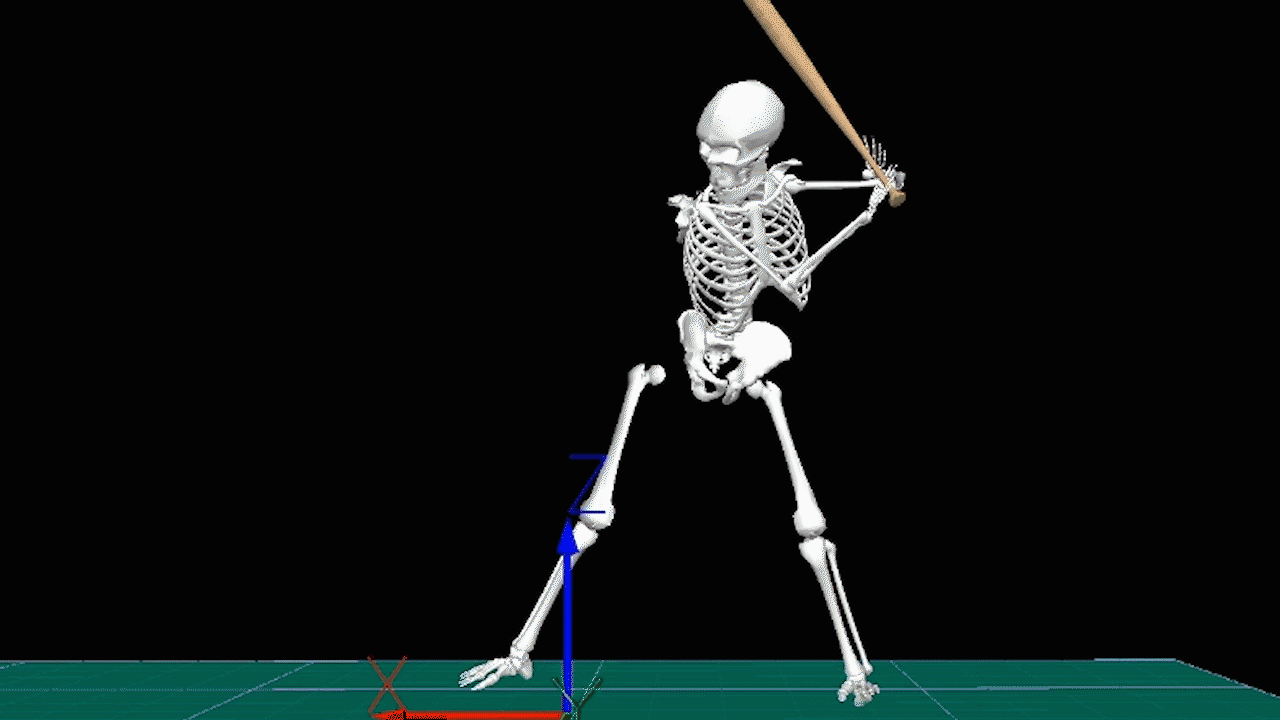
Foundations of Hitting
30 modules teaching you everything we know about hitting and hitting mechanics.
As far as approach goes, I generally subscribe to the idea that deliberately thinking about things like mechanics and where you’re looking decreases a hitter’s ability to react and perform in a competitive setting.
I do believe that being in the flow state is important, and shutting off outside thoughts when in a competitive setting provides an advantage. However, the training setting may be a good place to focus on improving visual strategies. I’ll touch on this later, but this is why I think it is useful to try to understand where hitters look and how we can use that knowledge to develop better hitters.
Pre-ball release strategies
Rob Gray wrote a great piece laying out possible strategies to capture this pre-ball release information on his blog. He talked about four potential strategies and which ones seemed most realistic in light of previously published literature and neurological limitations.

Image from The Perception & Action Blog by Rob Gray
The two prevailing ideas were visual pivot point and soft-focus strategies. Without getting too far into this (really, read Rob’s post, it’s awesome), the visual pivot point strategy is when a hitter focuses on the pitcher’s throwing elbow or shoulder, so they don’t have to shift their focus. Soft focus is when a hitter collects information from a wide area instead of focusing on one specific spot.
Gray discusses another strategy that we have most frequently observed with our hitters in a live setting using gaze tracking. Let’s call it the saccadic strategy, or when hitters focus on the pitcher’s body during their windup and delivery but follow this with a fast shift of focus to the pitcher’s release point. Before I try to explain it more, take a look at this gif.
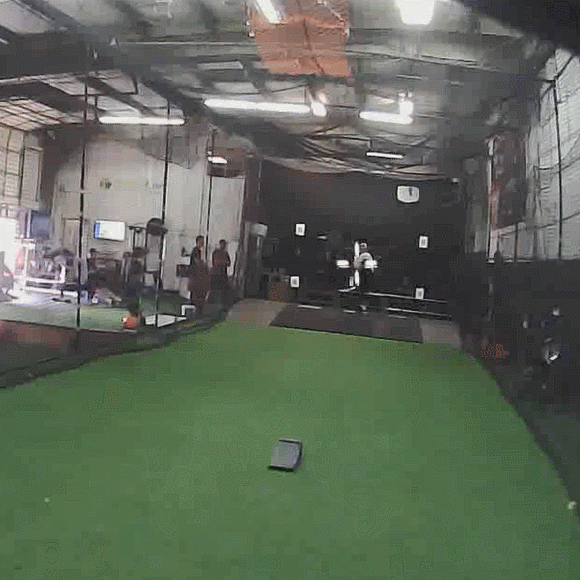
The shift in focus I am referring to happens around the time the pitcher’s front foot makes contact with the ground—you can see the hitter’s gaze position (the white dot and cross) shift upwards and to the left. I should mention that the eye movement doesn’t seem to be triggered by the pitcher’s front foot making contact with the ground, but rather those two events often coincidentally happen at the same time.

Become the Hitter You Want To Be
Train at Driveline
Saccades and Hitting
A saccade is a shift in gaze position when eyes move quickly from one fixation point to another. Saccades can be problematic for hitters. Multiple studies found that visual information is lost during a saccade, meaning we can’t recognize the movement of an object as well during one of these fast eye movements (Binda et al. 2018).
The loss of visual information is called saccadic suppression, and Satoshi et al. illustrated this well in the plot below. You can see that the percentage of correctly identified motion (y-axis) significantly decreased during the duration of the saccade (the horizontal line at the top of the plot).
If we are losing visual information during a saccade, we probably don’t want to make saccadic movements right before the ball is released from the pitcher’s hand. We may not be able to see as much information from ball release—the primary reason this strategy is not a theoretical front runner.

Graphic from Satoshi et al 1988
However, the existence of saccadic suppression is not the only evidence suggesting a saccade from the pitcher’s body to their hand right before ball release would be disadvantageous for the hitter. Gray also cites Kato et al., published in 2002, which compared the pre-pitch visual patterns of ordinary university students with those of collegiate baseball players.
They found that the members of the expert group (college athletes) were not only more consistent in where they looked, but also positioned their gaze closer to the throwing elbow than the pitcher’s body during the delivery.
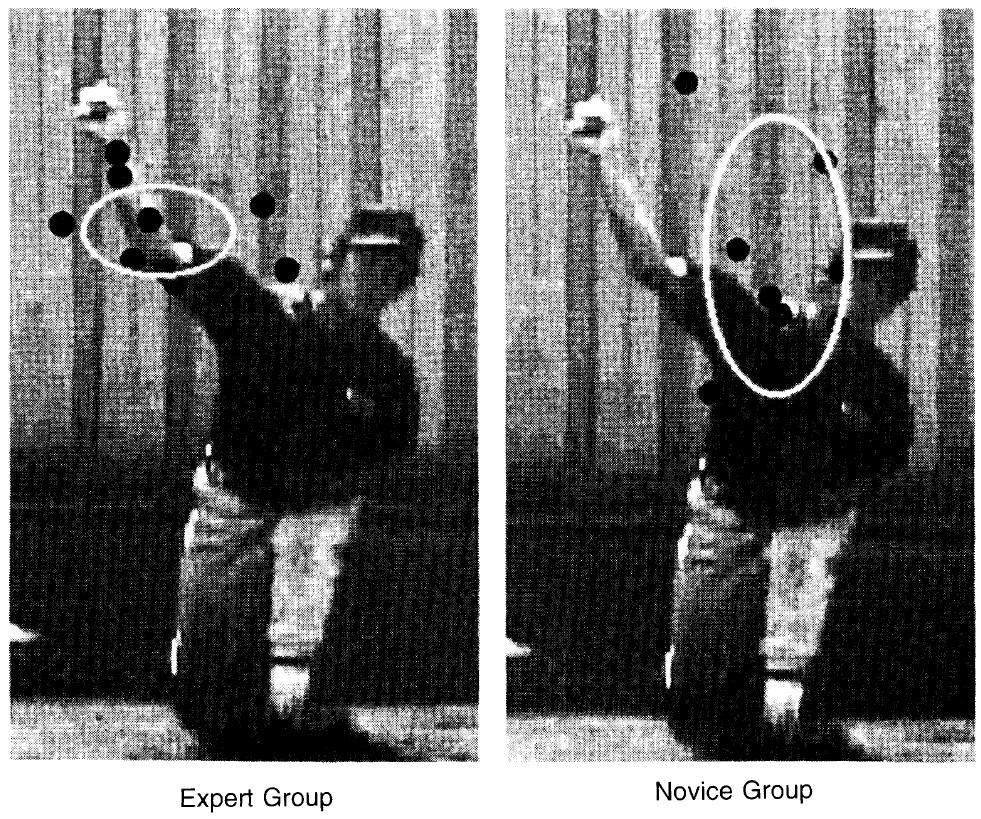
Graphic from Kato et al. 2002
If you are conflicted about which strategy is the most commonly used among the competitive hitting population in light of controversial evidence, then you are not alone. I am too. The existence of saccadic suppression and some evidence supporting the use of a visual pivot point on the pitcher’s elbow might suggest that hitters would not benefit from moving their eyes just before a pitcher delivers the ball; however, other evidence suggests that experienced hitters could do exactly that.
First, despite the evidence that we lose visual information while we execute saccades, multiple studies have found that hitters use saccadic movements during ball flight in baseball and cricket hitting (Kishita et al. 2020, Mann et al. 2013). Kishita et al. found that big league hitters initiate this saccade later than minor league hitters, but they execute the movement nonetheless. Mann et al. found that cricket hitters also use saccades to anticipate the location of ball bounce and the location of bat-ball contact.
If saccades (or just fast eye movements) are being used while tracking the ball, it seems plausible that we also use them before the ball is released. To try to explain how it’s still possible to use a saccade during ball flight tracking, I jumped into some basic perception research.
Basic Perception Research
As it turns out, saccadic “suppression” doesn’t necessarily mean all the information outside of our awareness is lost. The suppressed information can still be processed by the visual system (Watson et al. 2009). Watson et al. showed that despite participants being unaware of the visual stimulus presented during saccades in their experiment, the visual stimulus still affected their post-saccade perception. They call this saccadic omission.
It’s a little confusing—even though the participants were not consciously aware of a straight black line presented to them during their fast eye movement, it changed the perceived shape of an object displayed after the fast eye movement was over, even though the actual shape being displayed was always the same. As you can see in the figure below, the circle was perceived as an oval in a direction that is dependent on the direction of the straight line presented during a saccade.

Figure from Watson et al. 2009
This finding is far removed from applied baseball research. However, it provides some evidence that our visual system can still collect and process information during a saccade, despite the breadth of research outlining the suppression of visual ability during such eye movements. With that in mind, let’s take another look at the overwhelming evidence that our hitters use this saccadic strategy.
Here is a hitter executing the saccadic strategy in slow motion. You can see his gaze position (red dot and cross) moving upwards and outwards around the time of the pitcher’s front foot plant.
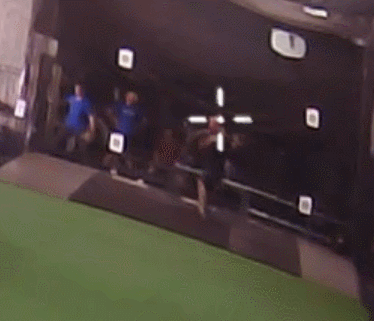
Similarly, the following gif shows a hitter facing a sidearm pitcher. This is interesting because the sidearm delivery is much less common than an over the top or three-quarters delivery, and we can see that hitters (or at least this hitter) still apply a saccadic strategy.

If you look very closely, you can see the hitter’s gaze position shift twice. It’s unknown whether the second saccade was to correct the location of the first saccade or if that is the hitter’s common solution to facing a sidearm slot.
Next, here is another example from one of the most accomplished hitters we have had in the gym.
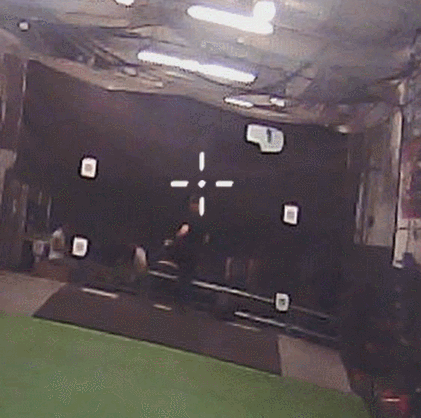
This pattern emerges in nearly all data we collect with acceptable calibrations, from amateur to professional hitters. Although our dataset is still limited in terms of sample size, it is becoming increasingly clear this is a viable pre-pitch strategy. Additionally, if we factor in the 2002 study from Kato et al., the difference in hitters’ gaze positions at the end of phase 1 and 3 can also be interpreted as support for the use of saccades.
If we take another look at that 2002 study, we can see there is a clear difference in hitter’s gaze position between the pitcher’s windup (left photo below) and at the time of ball release (right photo below). Eye movement from the pitcher’s body to the visual pivot point has to happen between these two phases in the pitcher’s delivery.
Since they did not report the transition of gaze position between phases, we can’t be sure if these hitters used a saccade to move their gaze from the pitcher’s body to the elbow. Still, it seems reasonable to assume they deployed a similar strategy to what we see here at Driveline.
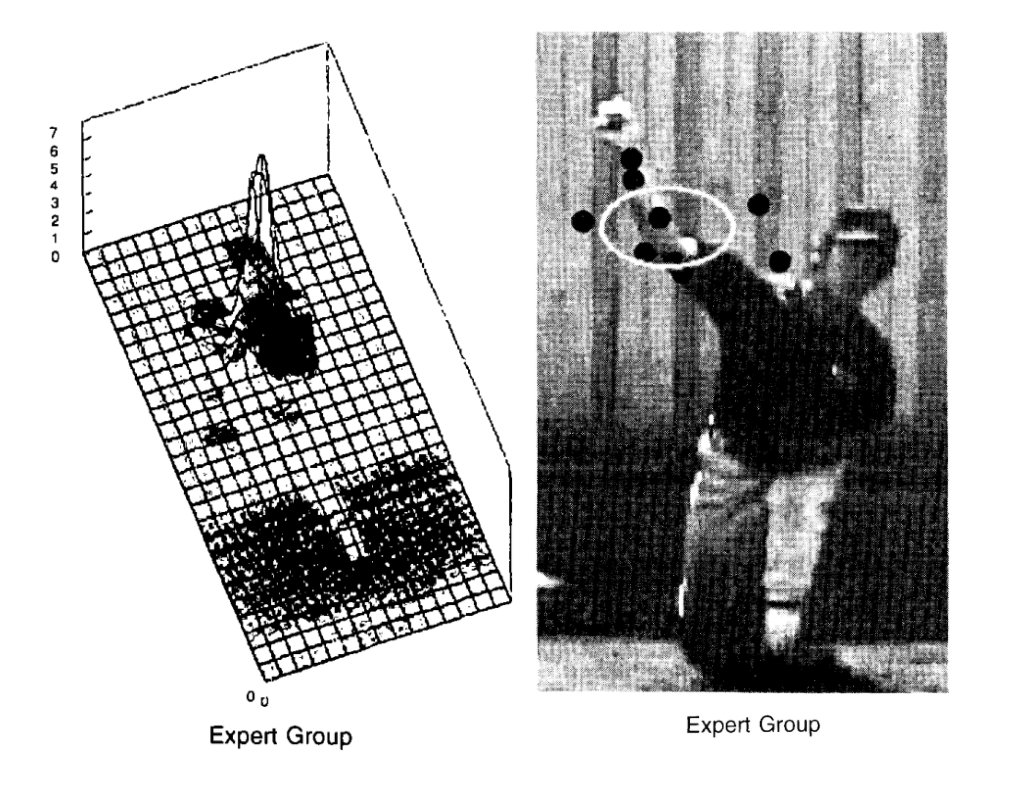
Images from Kato et al. 2002
Alright man, get to the point
Despite some limitations in our current dataset and the consequent analyses, we can be confident that many hitters use a strategy involving a saccadic shift from a focal point on the pitcher’s body to somewhere closer to the release point of the pitch.
This is supported by the gaze tracking data we have collected thus far, a saccadic suppression revisit, and a slight reframing of the interpretation of a study long supporting the use of a visual pivot point. The destination of this saccadic movement—whether the pitcher’s throwing elbow or hand at release point—is unclear, but our current dataset suggests it is closer to the hand than the elbow.
We are some time away from being able to fully apply this knowledge and its many nuances, but there are some takeaways that we can use to potentially improve training systems.
Improving machine batting practice
If we know that hitters’ eyes are not stationary while they prepare for the pitch in a live setting, and we know that they move their eyes from a position on the pitcher’s body to a position on the pitcher’s arm at the time of ball release, we can create machine batting practice environments that more closely represent facing a real pitcher.

Mixing in more practice against live pitchers
This idea has already talked about—teams across baseball have hired pitchers to throw game-like batting practice—but our data provides even more support for this type of training. More exposure to game-like, live arms can help improve hitters’ ability to predict the location of ball release, in turn improving their ‘internal model’ for recognizing trends and predicting pitch characteristics.
This is becoming a thing. At least one MLB team carries 1+ ex-pro live BP arms on their staff.
I feel like I should defer to @bruinmcmillan who has a tremendous story about Barry Bonds, competitive batting practice, and when he saw something different at UCLA. Enjoy. https://t.co/dgHPiOoHl9 pic.twitter.com/XlOEdE2fsQ
— Kyle Boddy (@drivelinebases) April 5, 2020
Mixed pitch batting practice and “short box” training
Short box and mixed pitch batting practice (rather than fastball-only batting practice) are two additional ways we can better replicate a game-like environment in the training setting. We implement short box in-gym every week, which has been a good way to provide competition for athletes in the training setting and work on their approach against unknown pitch sequences. It also has the benefit of replicating the perception of a live arm better than some other batting practice modalities.
Ideas 1 and 2 warrant additional investigations to optimize training methods, but given the current state of hitting vision training and research, all three of these ideas are pretty safe bets to improve batting practice if you were to begin implementation.
Future directions of this research
Given the research into the time it takes for a swing/no-swing decision, and the time it takes to swing the bat, much of the swing decision may happen before the ball is in flight. In this case, we can begin to identify those specific cues on the pitcher’s body and in their movement, which provide the most information for accurate decision making and ball flight prediction—not to mention the doors that open when we begin to quantify hitters’ gaze behaviors.
Upon the development of valid quantitative gaze tracking metrics, we can begin to quantitatively compare visual strategies between different hitters and different conditions. For example, we could analyze visual strategies of different groups of hitters (e.g. professionals vs. amateurs) and/or different conditions (e.g. machine batting practice vs. short box vs. live batting practice).
The following plot is an early example—we used our gaze tracking system to compare hitters’ visual strategies in short-box with their visual strategies against live pitchers. We compared the magnitude of their saccadic shift (from the pitcher’s body to their arm) against a live pitcher at 60 feet 6 inches and a live pitcher in short-box (about 50 feet). We found that they are highly correlated within each athlete. This provides more support for the use of short-box as a training tool for hitters by showing how similar a hitter’s visual strategy is between live and short box environments.

Warning: Small sample size
As we begin to create more quantitative measurements, we can validate them by investigating how they relate to actual hitting performance.
Do better hitters also perform better in our chosen metrics? If not, we need to rethink what or how we measure gaze behavior. Do our metrics correlate with higher xwOBA or other in-game performance statistics? The results of these validations are going to be the most powerful. They will allow us to take another step forward in beating pitchers in this game that is increasingly dominated by powerful pitch arsenals.
For more commentary on gaze tracking and other research initiatives coming out of the Driveline R&D department, tune in to the Driveline R&D podcast. New episodes are released every Monday.
Train at Driveline
Interested in training with us? Both in-gym and remote options are available!
- Athlete Questionnaire: Fill out with this link
- Email: support@drivelinebaseball.com
- Phone: 425-523-4030
By Kyle Lindley
References
Binda, P., & Morrone, M. C. (2018). Vision During Saccadic Eye Movements. Annual Review of Vision Science, 4, 193–213.
Kato, T., & Fukuda, T. (2002). Visual search strategies of baseball batters: Eye movements during the preparatory phase of batting. Perceptual and Motor Skills, 94(2), 380–386. https://doi.org/10.2466/pms.2002.94.2.380
Mann, D. L., Spratford, W., & Abernethy, B. (2013). The Head Tracks and Gaze Predicts: How the World’s Best Batters Hit a Ball. PLoS ONE, 8(3), 1–11. https://doi.org/10.1371/journal.pone.0058289
Watson, T. L., & Krekelberg, B. (2009). The Relationship between Saccadic Suppression and Perceptual Stability. Current Biology, 19(12), 1040–1043. https://doi.org/10.1016/j.cub.2009.04.052
Kishita, Y., Ueda, H., & Kashino, M. (2020). Eye and Head Movements of Elite Baseball Players in Real Batting. Frontiers in Sports and Active Living, 2. https://doi.org/10.3389/fspor.2020.00003
Comment section